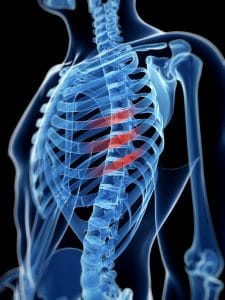Broken and Fractured Ribs from Car Crashes
 Car wrecks and accidents often result in blunt force trauma injuries to drivers and passengers, which can lead to serious internal damage to the body. For example, in vehicle collisions, victims can be forcefully thrown against the dashboard, steering wheel, or seatbelt, resulting in injuries like ribcage breaks and fractures.
Car wrecks and accidents often result in blunt force trauma injuries to drivers and passengers, which can lead to serious internal damage to the body. For example, in vehicle collisions, victims can be forcefully thrown against the dashboard, steering wheel, or seatbelt, resulting in injuries like ribcage breaks and fractures.
Although a broken rib may not seem like a serious injury at first glance, the rib cage protects our most vital organs from damage. When our ribs are cracked or broken, organs like the lungs and heart become vulnerable – leaving a victim open to life-threatening complications and conditions.
What are common rib injuries from car accidents?
After any type of car accident, it is important to seek medical attention immediately – especially if you feel pain in the chest or rib area. Common rib area trauma resulting from motor vehicle crashes include the following:
- Bruising. Bruised ribs include injury to the tissues, cartilage, and muscles of the chest wall. Patients may experience chest pain, tenderness, swelling, and visible external bruising.
- Costochondral separation. This occurs when the ribs tear away from the cartilage connecting the rib to the breastbone or sternum, caused by a sudden impact to the chest.
- Intercostal strain. The intercostal muscles help keep the ribs attached to each other. Direct trauma to the ribs can cause these muscles to pull, tear, or stretch, causing pain.
- Flail chest. One of the most serious rib injuries possible, flail chest happens when three or more ribs in a row sustain multiple fractures. This can cause part of your chest wall to become separated, resulting in a medical emergency.
- Fractured and broken ribs. Any kind of blunt force impact to the chest or ribcage can cause fractures and breaks. These injuries may result in serious pain and affect the patient’s ability to breathe, as well as potentially cause internal complications.
- Soft tissue injuries. The tissues and muscles surrounding the ribs can suffer injuries and tears in any type of accident. This can make it difficult to move and breathe, causing pain and complications.
Often, injuries to the ribs have similar symptoms – tenderness, sharp pain, and swelling. It is important to have a medical professional diagnose your injuries in order to get the proper treatment.
What are the symptoms of a serious rib injury?
Yale Medicine notes that any rib injury requires medical intervention, as rib fractures and breaks can be complicated by other injuries. After an accident, you may have experienced a rib injury if you have pain when taking a deep breath, apply pressure to the injured area, or when bending/twisting that part of the body. You may also see physical bruising or swelling.
Yale advises getting emergency care immediately for a rib injury if you experience the following symptoms:
- Increasing shortness of breath
- Trouble breathing deeply or coughing
- Fever
- Unusual cough, or a cough that produces mucus or blood
- Feeling dizzy or weak
- Abdominal pain
- Chest pain
Depending on the severity of your injuries, you may need a substantial amount of time from which to recover from your accident. An experienced Charlotte injury attorney works to ensure you are fully compensated for your losses.
When do ribcage injuries become life-threatening?
Make sure you receive medical attention after any type of trauma to the rib area. Your ribcage protects vital organs, and complications associated with rib injuries can be serious or even fatal, including:
- Pneumothorax. Also called a collapsed lung, this occurs when a broken rib tears into the lung or chest wall, drastically changing the pressure inside the chest. This can cause difficulty breathing, chest pain, or coughing up blood.
- Cardiac injury. When a ribcage injury causes trauma to the aorta or coronary arteries, a patient can suffer life-threatening injury or death.
- Ruptured spleen. Our spleen is protected by the ribs, and is responsible for filtering abnormal cells from our bodies, as well as manufacture some antibodies and helpful cells. When a broken rib ruptures the spleen, it can cause blood to spill into the abdominal cavity.
Your ER doctor or urgent care physician can run diagnostic tests to determine the extent of your rib injuries.
How are rib injuries diagnosed and treated?
Most ribcage injuries are diagnosed via imaging tests, although your doctor will likely give you a physical exam first. They will ask you about the incident that caused your injuries, listen to your symptoms, and check your breathing. Imaging tests used to diagnose rib injuries include bone scans, CT scans, MRIs, and X-rays.
Treatment for rib injuries can be complicated, as ribs cannot be put into a cast to immobilize them during the healing process. Most doctors no longer recommend the taping or binding of ribs during healing, as this tends to prevent the chest from fully expanding and contracting during breathing, which can lead to respiratory complications.
Healthline also notes that “your doctor may prescribe medication to help manage your pain. Long-lasting anesthetic injections near the site of the bruise may also help temporarily keep your nerves there from relaying pain signals to your brain.”
The main treatment for broken and fractured ribs is rest, typically four weeks minimum.
The car and truck accident attorneys at Warren & Kallianos, PLLC have decades of combined experience helping victims injured by negligent drivers. We work to determine the full extent of your injuries as well as the full and proper amount of compensation you need to recover. Let us help you today. Call us in Charlotte at 704-377-7777, or schedule an appointment by filling out our contact form.

At Warren & Kallianos, we believe in the importance of working directly with our attorneys, Jeff Warren and Chris Kallianos. When you work with our firm, Jeff and Chris are always accessible to you throughout the progress of your case.
Read more about Warren & Kallianos, PLLC
